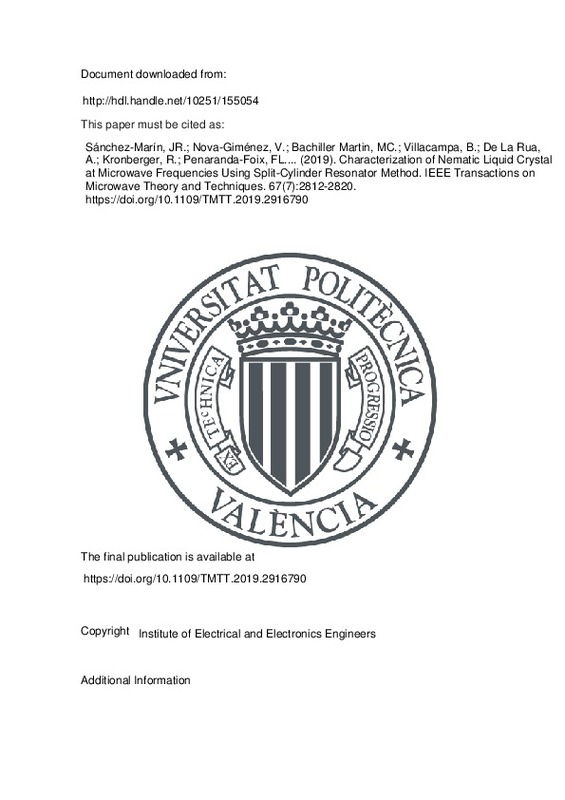JavaScript is disabled for your browser. Some features of this site may not work without it.
Buscar en RiuNet
Listar
Mi cuenta
Estadísticas
Ayuda RiuNet
Admin. UPV
Characterization of Nematic Liquid Crystal at Microwave Frequencies Using Split-Cylinder Resonator Method
Mostrar el registro sencillo del ítem
Ficheros en el ítem
| dc.contributor.author | Sánchez-Marín, Juan Rafael
|
es_ES |
| dc.contributor.author | Nova-Giménez, Vicente
|
es_ES |
| dc.contributor.author | Bachiller Martin, Maria Carmen
|
es_ES |
| dc.contributor.author | Villacampa, Belén
|
es_ES |
| dc.contributor.author | de la Rua, Alberto
|
es_ES |
| dc.contributor.author | Kronberger, Rainer
|
es_ES |
| dc.contributor.author | Penaranda-Foix, Felipe L.
|
es_ES |
| dc.contributor.author | Boria Esbert, Vicente Enrique
|
es_ES |
| dc.date.accessioned | 2020-11-14T04:31:07Z | |
| dc.date.available | 2020-11-14T04:31:07Z | |
| dc.date.issued | 2019-07 | es_ES |
| dc.identifier.issn | 0018-9480 | es_ES |
| dc.identifier.uri | http://hdl.handle.net/10251/155054 | |
| dc.description.abstract | [EN] Liquid crystal (LC) is an anisotropic liquid material, which flows like a liquid, but at the same time, its molecules have an orientational order like in the solid state. Thus, LC is a promising dielectric material for designing reconfigurable devices at microwave frequencies. In order to optimize the design of reconfigurable microwave devices, accurate values of the dielectric permittivity and the loss tangent of LCs are needed. However, new LCs are not well characterized at these frequencies because of its recent use for microwave applications. Therefore, the characterization in this frequency range is required for its practical use within microwave components and devices. In this paper, a split-cylinder resonator method is used for the characterization of four different nematic LCs at two frequency points, i. e., 5 and 11 GHz. This characterization includes the extraction of their complex dielectric permittivity values at these frequencies. The employed method allows to obtain the two extreme permittivity values without applying any external electric or magnetic field to polarize the LC molecules. Two different approaches, a modal analysis method and a full-wave numerical technique, have been used for determining the LC parameters obtaining similar results in both cases. | es_ES |
| dc.description.sponsorship | This work was supported in part by the Generalitat Valenciana Research under Project PROMETEOII/2015/005, in part by the Ministerio de Educacion, Cultura y Deporte, Spain, through the Fellowship Program for Training University Professors under Grant FPU14/00150, in part by the Ministerio de Economia y Competitividad, Spain through Research and Development Projects under Grant TEC2016-75934-C4-R-1, and in part by the Gobierno de Aragon-Fondo Europeo de Desarrollo Regional (FEDER)-Fondo Social Europeo 2017-2019 under Reference E14-7R. | es_ES |
| dc.language | Inglés | es_ES |
| dc.publisher | Institute of Electrical and Electronics Engineers | es_ES |
| dc.relation.ispartof | IEEE Transactions on Microwave Theory and Techniques | es_ES |
| dc.rights | Reserva de todos los derechos | es_ES |
| dc.subject | Dielectric permittivity characterization | es_ES |
| dc.subject | Liquid crystal (LC) | es_ES |
| dc.subject | Microwave devices | es_ES |
| dc.subject | Split-Cylinder resonator | es_ES |
| dc.subject.classification | TEORIA DE LA SEÑAL Y COMUNICACIONES | es_ES |
| dc.title | Characterization of Nematic Liquid Crystal at Microwave Frequencies Using Split-Cylinder Resonator Method | es_ES |
| dc.type | Artículo | es_ES |
| dc.identifier.doi | 10.1109/TMTT.2019.2916790 | es_ES |
| dc.relation.projectID | info:eu-repo/grantAgreement/MINECO//TEC2016-75934-C4-1-R/ES/DEMOSTRADORES TECNOLOGICOS DE FILTROS Y MULTIPLEXORES CON RESPUESTAS SELECTIVAS Y SINTONIZABLES EN NUEVAS GUIAS COMPACTAS PARA APLICACIONES ESPACIALES/ | es_ES |
| dc.relation.projectID | info:eu-repo/grantAgreement/MECD//FPU14%2F00150/ES/FPU14%2F00150/ | es_ES |
| dc.relation.projectID | info:eu-repo/grantAgreement/Gobierno de Aragón//E14-7R/ | es_ES |
| dc.relation.projectID | info:eu-repo/grantAgreement/GVA//PROMETEOII%2F2015%2F005/ES/AVANCES EN COMPONENTES (CIRCUITOS Y ANTENAS) DE MICROONDAS Y ONDAS MILIMETRICAS PARA FUTUROS SISTEMAS DE COMUNICACIONES ESPACIALES (FUTUR-SAT)/ | es_ES |
| dc.rights.accessRights | Abierto | es_ES |
| dc.contributor.affiliation | Universitat Politècnica de València. Instituto Universitario de Telecomunicación y Aplicaciones Multimedia - Institut Universitari de Telecomunicacions i Aplicacions Multimèdia | es_ES |
| dc.contributor.affiliation | Universitat Politècnica de València. Departamento de Comunicaciones - Departament de Comunicacions | es_ES |
| dc.description.bibliographicCitation | Sánchez-Marín, JR.; Nova-Giménez, V.; Bachiller Martin, MC.; Villacampa, B.; De La Rua, A.; Kronberger, R.; Penaranda-Foix, FL.... (2019). Characterization of Nematic Liquid Crystal at Microwave Frequencies Using Split-Cylinder Resonator Method. IEEE Transactions on Microwave Theory and Techniques. 67(7):2812-2820. https://doi.org/10.1109/TMTT.2019.2916790 | es_ES |
| dc.description.accrualMethod | S | es_ES |
| dc.relation.publisherversion | https://doi.org/10.1109/TMTT.2019.2916790 | es_ES |
| dc.description.upvformatpinicio | 2812 | es_ES |
| dc.description.upvformatpfin | 2820 | es_ES |
| dc.type.version | info:eu-repo/semantics/publishedVersion | es_ES |
| dc.description.volume | 67 | es_ES |
| dc.description.issue | 7 | es_ES |
| dc.relation.pasarela | S\389320 | es_ES |
| dc.contributor.funder | Gobierno de Aragón | es_ES |
| dc.contributor.funder | European Social Fund | es_ES |
| dc.contributor.funder | Generalitat Valenciana | es_ES |
| dc.contributor.funder | European Regional Development Fund | es_ES |
| dc.contributor.funder | Ministerio de Economía y Competitividad | es_ES |
| dc.contributor.funder | Ministerio de Educación, Cultura y Deporte | es_ES |







![[Cerrado]](/themes/UPV/images/candado.png)

